Power electronic handbook
Подождите немного. Документ загружается.


34 Control Methods for Switching Power Converters 957
output requirements, Eq. (34.83) would give extremely high
values for the control input u
h
(t), which would be impractical
or almost impossible.
In most switching converters u
h
(t) is discontinuous. Yet,
if we assume one or more discontinuity borders dividing the
state-space into subspaces, the existence and uniqueness of
the solution is guaranteed out of the discontinuity borders,
since in each subspace the input is continuous. The discon-
tinuity borders are subspace switching hypersurfaces, whose
order is the space order minus one, along which the subsystem
state slides, since its intersections with the auxiliary equations
defining the discontinuity surfaces can give the needed control
input.
Within the sliding-mode control (SMC) theory, assuming a
certain dynamic error tending to zero, one auxiliary equation
(sliding surface) and the equivalent control input u
h
(t) can be
obtained, integrating both sides of Eq. (34.82) with null initial
conditions:
k
j
x
j
j−1
i=h
k
i
x
i
=
j
i=h
k
i
x
i
= 0 (34.84)
This equation represents the discontinuity surface (hyper-
plane) and just defines the necessary sliding surface S(x
i
, t)to
obtain the prescribed dynamics of Eq. (34.81):
S(x
i
, t) =
j
i=h
k
i
x
i
= 0 (34.85)
In fact, by taking the first time derivative of S(x
i
, t),
˙
S(x
i
, t) = 0, solving it for dx
j
/dt, and substituting the result in
Eq. (34.83), the dynamics specified by Eq. (34.81) is obtained.
This means that the control problem is reduced to a first-
order problem, since it is only necessary to calculate the time
derivative of Eq. (34.85) to obtain the dynamics (34.81) and
the needed control input u
h
(t).
The sliding surface Eq. (34.85), as the dynamics of the con-
verter subsystem, must be a Routh–Hurwitz polynomial and
verify the sliding manifold invariance conditions, S(x
i
, t) = 0
and
˙
S(x
i
, t) = 0. Consequently, the closed-loop controlled sys-
tem behaves as a stable system of order j −h, whose dynamics
is imposed by the coefficients k
i
, which can be chosen by pole
placement of the poles of the order m = j − h polynomial.
Alternatively, certain kinds of polynomials can be advanta-
geously used [15]: Butterworth, Bessel, Chebyshev, elliptic
(or Cauer), binomial, and minimum integral of time abso-
lute error product (ITAE). Most useful are Bessel polynomials
B
E
(s) Eq. (34.88), which minimize the system response time t
r
,
providing no overshoot, the polynomials I
TAE
(s) Eq. (34.87),
that minimize the ITAE criterion for a system with desired nat-
ural oscillating frequency ω
o
, and binomial polynomials B
I
(s)
Eq. (34.86). For m > 1, ITAE polynomials give faster responses
than binomial polynomials.
B
I
(s)
m
=(s +ω
o
)
m
=
m =0⇒B
I
(s)=1
m =1⇒B
I
(s)=s +ω
o
m =2⇒B
I
(s)=s
2
+2ω
o
s +ω
2
o
m =3⇒B
I
(s)=s
3
+3ω
o
s
2
+3ω
2
o
s +ω
3
o
m =4⇒B
I
(s)=s
4
+4ω
o
s
3
+6ω
2
o
s
2
+4ω
3
o
s +ω
4
o
...
(34.86)
I
TAE
(s)
m
=
m =0⇒I
TAE
(s)=1
m =1⇒I
TAE
(s)=s +ω
o
m =2⇒I
TAE
(s)=s
2
+1.4ω
o
s +ω
2
o
m =3⇒I
TAE
(s)=s
3
+1.75ω
o
s
2
+2.15ω
2
o
s +ω
3
o
m =4⇒I
TAE
(s)=s
4
+2.1ω
o
s
3
+3.4ω
2
o
s
2
+2.7ω
3
o
s +ω
4
o
...
(34.87)
B
E
(s)
m
=
m =0⇒B
E
(s)=1
m =1⇒B
E
(s)=st
r
+1
m = 2⇒B
E
(s)=
(st
r
)
2
+3st
r
+3
3
m =3⇒B
E
(s)=
(st
r
)
2
+3.678st
r
+6.459
(
st
r
+2.322
)
15
=
(
st
r
)
3
+6
(
st
r
)
2
+15st
r
+15
15
m =4⇒B
E
(s)=
(
st
r
)
4
+10
(
st
r
)
3
+45
(
st
r
)
2
+105
(
st
r
)
+105
105
...
(34.88)
These polynomials can be the reference model for this model
reference adaptive control method.
34.3.2.2 Closed-loop Control Input–Output
Decoupled Form
For closed-loop control applications, instead of the state
variables x
i
, it is worthy to consider, as new state vari-
ables, the errors e
x
i
, components of the error vector e =
e
x
h
, ˙e
x
h
, ¨e
x
h
, ...,
m
e
x
h
T
of the state-space variables x
i
, rela-
tive to a given reference x
i
r
Eq. (34.90). The new controllability
canonical model of the system is
d
dt
[e
x
h
, ..., e
x
j−1
, e
x
j
]
T
=[e
x
h+1
, ..., e
x
j
, −f
e
(e) + p
e
(t)
−b
e
(e)u
h
(t)]
T
(34.89)
where f
e
(e), p
e
(t), and b
e
(e) are functions of the error vector e.

958 J. F. Silva and S. F. Pinto
As the transformation of variables
e
x
i
= x
i
r
−x
i
with i = h, ..., j (34.90)
is linear, the Routh–Hurwitz polynomial for the new sliding
surface S(e
x
i
, t)is
S(e
x
i
, t) =
j
i=h
k
i
e
x
i
= 0 (34.91)
Since e
x
i+1
(s) = se
x
i
(s), this control law, from Eqs. (34.86–
34.88) can be written as S(e,s) = e
x
i
(s+ω
o
)
m
, does not depend
on circuit parameters, disturbances, or operating conditions,
but only on the imposed k
i
parameters and on the state vari-
able errors e
x
i
, which can usually be measured or estimated.
The control law Eq. (34.91) enables the desired dynamics of
the output variable(s), if the semiconductor switching strat-
egy is designed to guarantee the system stability. In practice,
the finite switching frequency of the semiconductors will
impose a certain dynamic error ε tending to zero. The control
law Eq. (34.91) is the required controller for the closed-loop
SISO subsystem with output y.
34.3.2.3 Stability
Existence condition. The existence of the operation in slid-
ing mode implies S(e
x
i
, t) = 0. Also, to stay in this regime,
the control system should guarantee
˙
S(e
x
i
, t) = 0. There-
fore, the semiconductor switching law must ensure the stability
condition for the system in sliding mode, written as
S(e
x
i
, t)
˙
S(e
x
i
, t) < 0 (34.92)
The fulfillment of this inequality ensures the convergence of
the system state trajectories to the sliding surface S(e
x
i
, t) = 0,
since
–ifS(e
x
i
, t) > 0 and
˙
S(e
x
i
, t) < 0, then S(e
x
i
, t) will decrease
to zero,
–ifS(e
x
i
, t) < 0 and
˙
S(e
x
i
, t) > 0, then S(e
x
i
, t) will increase
toward zero.
Hence, if Eq. (34.92) is verified, then S(e
x
i
, t) will con-
verge to zero. The condition (34.92) is the manifold S(e
x
i
, t)
invariance condition, or the sliding-mode existence condition.
Given the statespace model Eq. (34.89) as a function of the
error vector e and, from
˙
S(e
x
i
, t) = 0, the equivalent average
control input U
eq
(t) that must be applied to the system in
order that the system state slides along the surface Eq. (34.91),
is given by
U
eq
(t) =
k
h
de
x
h
dt
+k
h+1
de
x
h+1
dt
+···+k
j−1
+
de
x
j−1
dt
+k
j
(
−f
e
(e)+p
e
(t)
)
k
j
b
e
(e)
(34.93)
This control input U
eq
(t) ensures the converter subsystem
operation in the sliding mode.
Reaching condition. The fulfillment of S(e
x
i
, t)
˙
S(e
x
i
, t) < 0,
as S(e
x
i
, t)
˙
S(e
x
i
, t) = (1/2)
˙
S
2
(e
x
i
, t), implies that the distance
between the system state and the sliding surface will tend to
zero, since S
2
(e
x
i
, t) can be considered as a measure for this
distance. This means that the system will reach sliding mode.
Additionally, from Eq. (34.89) it can be written:
de
x
j
dt
=−f
e
(e) + p
e
(t) − b
e
(e)u
h
(t) (34.94)
From Eq. (34.91), Eq. (34.95) is obtained.
S(e
x
i
, t) =
j
i=h
k
i
e
x
i
= k
h
e
x
h
+k
h+1
de
x
h
dt
+k
h+2
d
2
e
x
h
dt
2
+···+k
j
d
m
e
x
h
dt
m
(34.95)
If S(e
x
i
, t) > 0, from the Routh–Hurwitz property of
Eq. (34.91), then e
x
j
> 0. In this case, to reach S(e
x
i
, t) = 0it
is necessary to impose −b
e
(e)u
h
(t) =−U in Eq. (34.94), with
U chosen to guarantee de
x
j
/dt < 0. After a certain time, e
x
j
will be e
x
j
= d
m
e
x
h
/dt
m
< 0, implying along with Eq. (34.95)
that
˙
S(e
x
i
, t) < 0, thus verifying Eq. (34.92). Therefore, every
term of S(e
x
i
, t) will be negative, which implies, after a certain
time, an error e
x
h
< 0 and S(e
x
i
, t) < 0. Hence, the system
will reach sliding mode, staying there if U = U
eq
(t). This
same reasoning can be made for S(e
x
i
, t) < 0, it is now being
necessary to impose −b
e
(e)u
h
(t) =+U , with U high enough
to guarantee de
x
j
/dt > 0.
To ensure that the system always reaches sliding-mode oper-
ation, it is necessary to calculate the maximum value of U
eq
(t),
U
eqmax
, and also impose the reaching condition:
U > U
eqmax
(34.96)
This means that the power supply voltage values U should
be chosen high enough to additionally account for the maxi-
mum effects of the perturbations. With step inputs, even with
U > U
eqmax
, the converter usually loses sliding mode, but it
will reach it again, even if the U
eqmax
is calculated considering
only the maximum steady-state values for the perturbations.
34.3.2.4 Switching Law
From the foregoing considerations, supposing a system with
two possible structures, the semiconductor switching strategy
must ensure S(e
x
i
, t)
˙
S(e
x
i
, t) < 0. Therefore, if S(e
x
i
, t) > 0,
then
˙
S(e
x
i
, t) < 0, which implies, as seen, −b
e
(e)u
h
(t) =−U
(the sign of b
e
(e) must be known). Also, if S(e
x
i
, t) < 0,
then
˙
S(e
x
i
, t) > 0, which implies −b
e
(e)u
h
(t) =+U . This
imposes the switching between two structures at infinite fre-
quency. Since power semiconductors can switch only at finite
frequency, in practice, a small enough error for S(e
x
i
, t) must
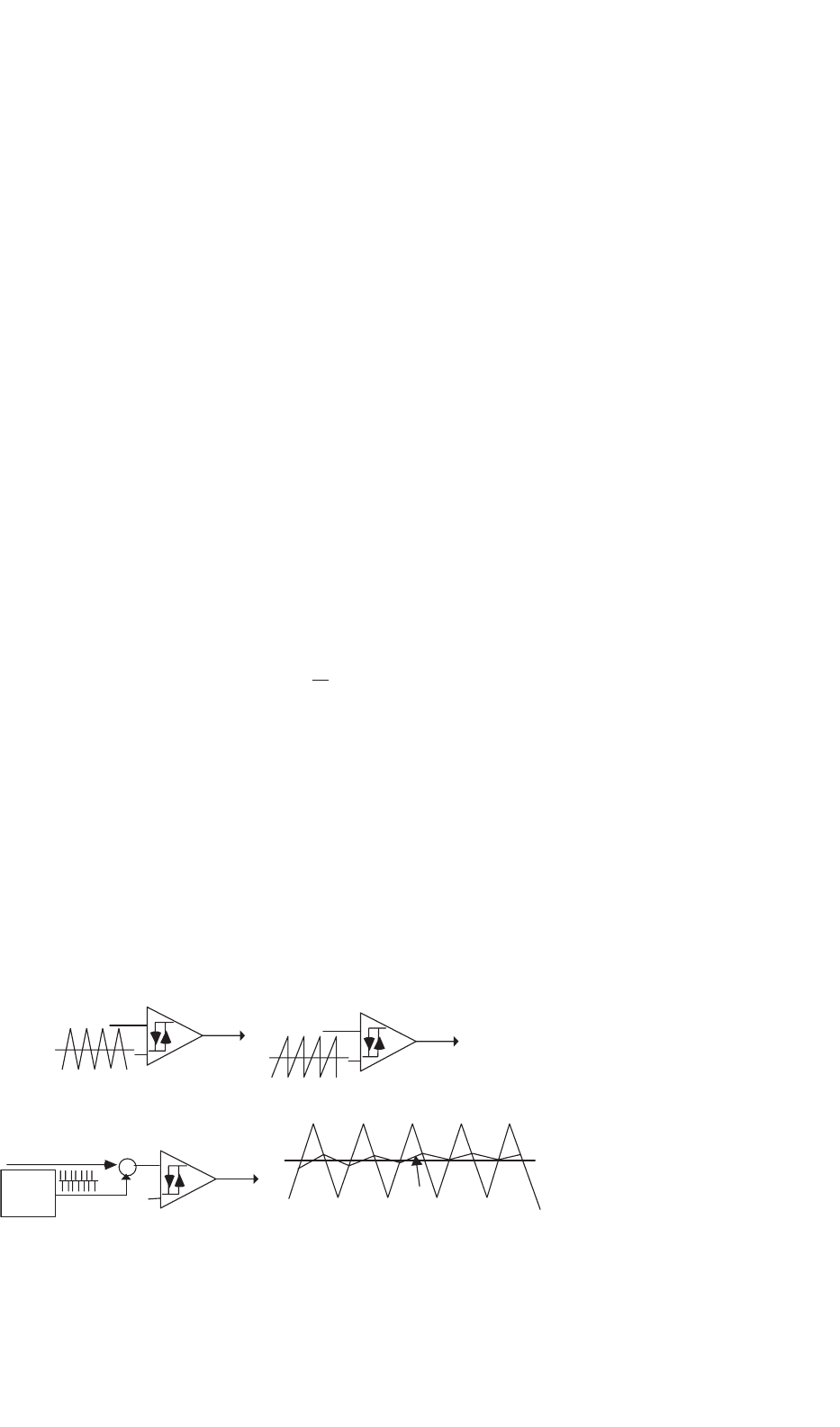
34 Control Methods for Switching Power Converters 959
be allowed (−ε<S(e
x
i
, t) < +ε). Hence, the switching law
between the two possible system structures might be
u
h
(t) =
U /be (e) for S(e
x
i
, t) > +e
−U /be (e) for S(e
x
i
, t) < −e
(34.97)
The condition Eq. (34.97) determines the control input to
be applied and therefore represents the semiconductor switch-
ing strategy or switching function. This law determines a
two-level pulse width modulator with JIT switching (variable
frequency).
34.3.2.5 Robustness
The dynamics of a system, with closed-loop control using the
control law Eq. (34.91) and the switching law Eq. (34.97), does
not depend on the system operating point, load, circuit param-
eters, power supply, or bounded disturbances, as long as the
control input u
h
(t) is large enough to maintain the converter
subsystem in sliding mode. Therefore, it is said that the switch-
ing converter dynamics, operating in sliding mode, is robust
against changing operating conditions, variations of circuit
parameters, and external disturbances. The desired dynamics
for the output variable(s) is determined only by the k
i
coeffi-
cients of the control law Eq. (34.91), as long as the switching
law (34.97) maintains the converter in sliding mode.
34.3.3 Constant-frequency Operation
Prefixed switching frequency can be achieved, even with
the sliding-mode controllers, at the cost of losing the JIT
action. As the sliding-mode controller changes the control
input when needed, and not at a certain prefixed rhythm,
applications needing constant switching frequency (such as
thyristor rectifiers or resonant converters), must compare
S(e
x
i
, t) (hysteresis width 2ι much narrower than 2ε) with
auxiliary triangular waveforms (Fig. 34.25a), auxiliary saw-
tooth functions (Fig. 34.25b), three-level clocks (Fig. 34.25c),
or phase locked loop control of the comparator hysteresis
uh(t)
u
h(t)
2i
2i
+
+
−
−
S(ex
i
,t)
(b)
u
h(t)
2i
+
+
+
S(ex
i
,t)
0
Three
Level
Clock
(
c
)
(a)
(
d
)
S(ex
i
,t)
S(ex
i
,t)
FIGURE 34.25 Auxiliary functions and methods to obtain constant switching frequency with sliding-mode controllers.
variable width 2ε[16]. However, as illustrated in Fig. 34.25d,
steady-state errors do appear. Often, they should be eliminated
as described in Section 34.3.4.
34.3.4 Steady-state Error Elimination in
Converters with Continuous Control
Inputs
In the ideal sliding mode, state trajectories are directed toward
the sliding surface (34.91) and move exactly along the dis-
continuity surface, switching between the possible system
structures, at infinite frequency. Practical sliding modes can-
not switch at infinite frequency, and therefore exhibit phase
plane trajectory oscillations inside a hysteresis band of width
2ε, centered in the discontinuity surface.
The switching law Eq. (34.91) permits no steady-state errors
as long as S(e
x
i
, t) tends to zero, which implies no restrictions
on the commutation frequency. Control circuits operating at
constant frequency, or needed continuous inputs, or particular
limitations of the power semiconductors, such as minimum
on or off times, can originate S(e
x
i
, t) = ε
1
= 0. The steady-
state error (e
x
h
)ofthex
h
variable, x
h
r
− x
h
= ε
1
/k
h
, can be
eliminated, increasing the system order by 1. The new state-
space controllability canonical form, considering the error e
x
i
,
between the variables and their references, as the state vector, is
d
dt
e
x
h
dt, e
x
h
, ..., e
x
j−1
, e
x
j
T
=[e
x
h
, e
x
h+1
, ..., e
x
j
, −f
e
(e) − p
e
(t) − b
e
(e)u
h
(t)]
T
(34.98)
The new sliding surface S(e
x
i
, t), written from Eq. (34.91)
considering the new system Eq. (34.98), is
S(e
x
i
, t) = k
0
e
x
h
dt +
j
i=h
k
i
e
x
i
= 0 (34.99)
This sliding surface offers zero-state error, even if S(e
x
i
, t) =
ε
1
due to the hardware errors or fixed (or limited)

960 J. F. Silva and S. F. Pinto
frequency switching. Indeed, at the steady state, the only
nonnull term is k
0
e
x
h
dt = ε
1
. Also, like Eq. (34.91), this
closed-loop control law does not depend on system parameters
or perturbations to ensure a prescribed closed-loop dynamics
similar to Eq. (34.81) with an error approaching zero.
The approach outlined herein precisely defines the con-
trol law (sliding surface (34.91) or (34.99)) needed to obtain
the selected dynamics, and the switching law Eq. (34.97). As
the control law allows the implementation of the system con-
troller, and the switching law gives the PWM modulator, there
is no need to design linear or nonlinear controllers, based on
linear converter models, or devise offline PWM modulators.
Therefore, sliding-mode control theory, applied to switching
converters, provides a systematic method to generate both the
controller(s) (usually nonlinear) and the modulator(s) that
will ensure a model reference robust dynamics, solving the
control problem of switching converters.
In the next examples, it is shown that the sliding-mode con-
trollers use (nonlinear) state feedback, therefore, needing to
measure the state variables and often other variables, since
they use more system information. This is a disadvantage since
more sensors are needed. However, the straightforward con-
trol design and obtained performances are much better than
those obtained with the averaged models, the use of more sen-
sors being really valued. Alternatively to the extra sensors, state
observers can be used [13, 14].
34.3.5 Examples: Buck–Boost DC/DC
Converter, Half-bridge Inverter, 12-pulse
Parallel Rectifiers, Audio Power
Amplifiers, Near Unity Power Factor
Rectifiers, Multilevel Inverters, Matrix
Converters
EXAMPLE 34.10 Sliding-mode control of the buck–
boost dc/dc converter
Consider again the buck–boost converter of Fig. 34.1 and
assume the converter output voltage v
o
to be the con-
trolled output. From Section 34.2, using the switched
state-space model of Eq. (34.11), making dv
o
/dt = θ,
and calculating the first time derivative of θ, the con-
trollability canonical model (34.100), where i
o
= v
o
/R
o
,
is obtained:
dv
o
dt
= θ =
1 −δ(t)
C
o
i
L
−
i
o
C
o
dθ
dt
=−
(1 −δ(t))
2
L
i
C
o
v
o
−
C
o
θ +i
o
C
o
(1 −δ(t))
dδ(t )
dt
−
1
C
o
di
o
dt
+
δ(t)(1 − δ(t ))
C
o
L
i
V
DC
(34.100)
This model, written in the form of Eq. (34.80), con-
tains two state variables, v
o
and θ. Therefore, from
Eq. (34.91) and considering e
v
o
= v
o
r
−v
o
, e
θ
= θ
r
−θ,
the control law (sliding surface) is
S(e
x
i
, t) =
2
i=h
k
i
e
x
i
= k
1
(v
o
r
−v
o
) +k
2
dv
o
r
dt
−k
2
dv
o
dt
= k
1
(v
o
r
−v
o
) +k
2
dv
o
r
dt
−
k
2
C
o
(1 −δ(t))i
L
+
k
2
C
o
i
o
= 0 (34.101)
This sliding surface depends on the variable δ(t),
which should be precisely the result of the application,
in Eq. (34.101), of a switching law similar to Eq. (34.97).
Assuming an ideal up–down converter and slow varia-
tions, from Eq. (34.31) the variable δ(t) can be averaged
to δ
1
= v
o
/(v
o
+ V
DC
). Substituting this relation in
Eq. (34.101), and rearranging, Eq. (34.102) is derived:
S(e
x
i
,t)=
C
o
k
1
k
2
v
o
+V
DC
v
o
×
(v
o
r
−v
o
)+
k
2
k
1
dv
o
r
dt
+
k
2
k
1
1
C
o
i
o
−i
L
=0
(34.102)
This control law shows that the power supply voltage
V
DC
must be measured, as well as the output voltage v
o
and the currents i
o
and i
L
.
To obtain the switching law from stability considera-
tions (34.92), the time derivative of S(e
x
i
, t), supposing
(v
o
+V
DC
)/v
o
almost constant, is
˙
S(e
x
i
, t) =
C
o
k
1
k
2
v
o
+V
DC
v
o
×
de
v
o
dt
+
k
2
k
1
d
2
v
o
r
dt
2
+
k
2
k
1
C
o
di
o
dt
−
di
L
dt
(34.103)
If S(e
x
i
, t) > 0 then, from Eq. (34.92),
˙
S(e
x
i
, t) < 0
must hold. Analyzing Eq. (34.103), we can conclude
that, if S(e
x
i
, t) > 0,
˙
S(e
x
i
, t) is negative if, and only
if, di
L
/dt > 0. Therefore, for positive errors e
v
o
>0 the
current i
L
must be increased, which implies δ(t) = 1.
Similarly, for S(e
x
i
, t) < 0, di
L
/dt < 0 and δ(t) = 0.
Thus, a switching law similar to Eq. (34.97) is obtained:
δ(t) =
1 for S(e
x
i
, t) > +e
0 for S(e
x
i
, t) < −e
(34.104)
The same switching law could be obtained from
knowing the dynamic behavior of this nonminimum-
phase up-down converter: to increase (decrease) the
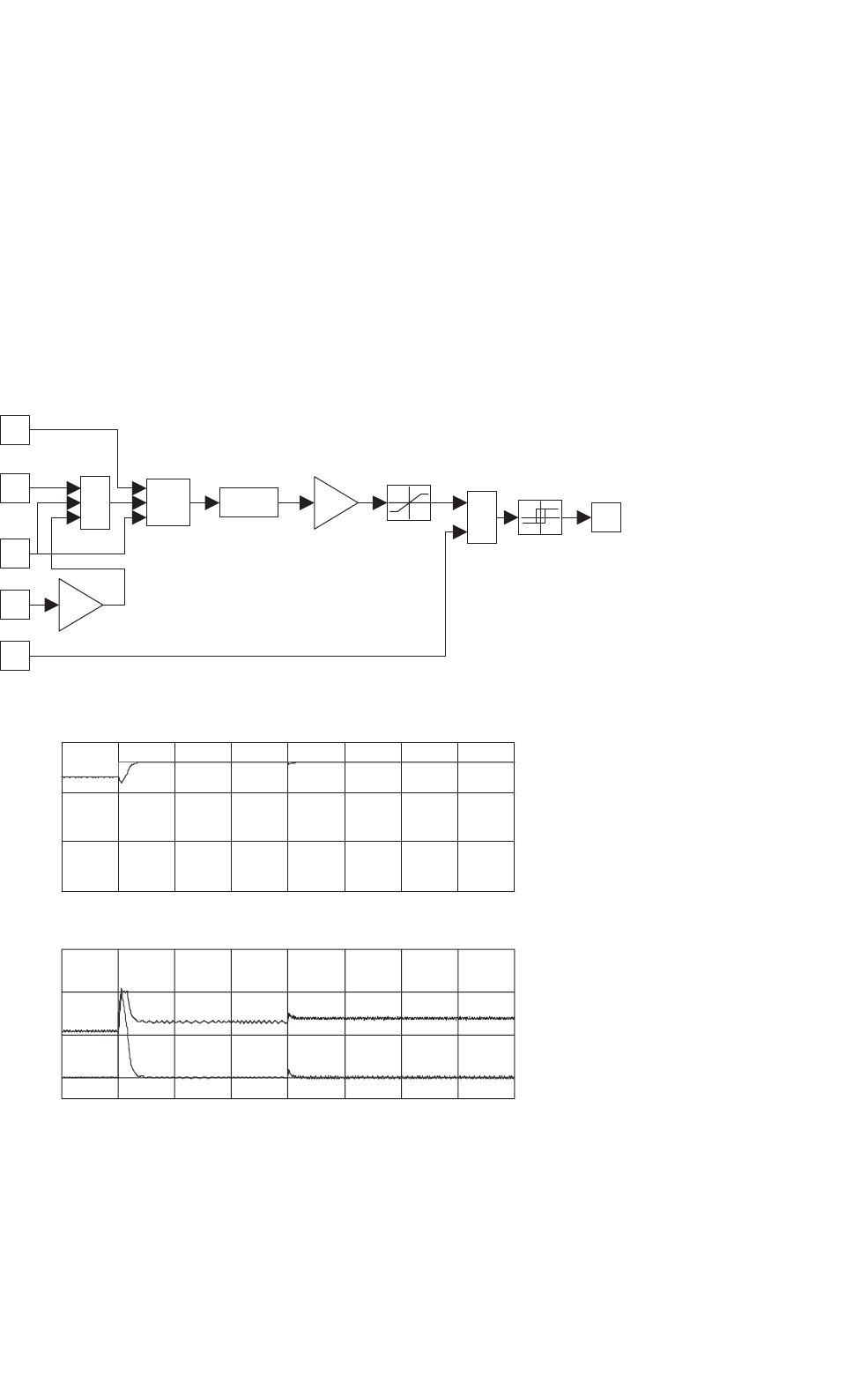
34 Control Methods for Switching Power Converters 961
output voltage, a previous increase (decrease) of the i
L
current is mandatory.
Equation (34.101) shows that, if the buck–boost con-
verter is into the sliding mode (S(e
x
i
, t) = 0), the
dynamics of the output voltage error tends exponentially
to zero with time constant k
2
/k
1
. Since during step tran-
sients, the converter is in the reaching mode, the time
constant k
2
/k
1
cannot be designed to originate error vari-
ations larger than the one allowed by the self-dynamics
of the converter excited by a certain maximum permissi-
ble i
L
current. Given the polynomials (34.86–34.88) with
m = 1, k
1
/k
2
= ω
o
should be much lower than the finite
switching frequency (1/T ) of the converter. Therefore,
1
delta
Switching
law
5
i
L
1/4
k2/(k1*Co)
4
i
o
+
−
Sum1
1
V
dc
Saturation
+
−
+
Sum
2
v
oref
Mux
Mux
3
v
o
f(u)
ev*(V
dc
+v
o
)/v
o
4
k1*C
o
/k2
0 0.005 0.01 0.015 0.02 0.025 0.03 0.035 0.04
0
10
20
30
1}voref, 2}vo [V]
t [s]
0 0.005 0.01 0.015 0.02 0.025 0.03 0.035 0.04
0
20
40
60
2}10*(voref-vo) [V], 1}iL[A]
t [s]
(b)
(a)
FIGURE 34.26 (a) Block diagram of the sliding-mode nonlinear controller for the buck–boost converter and (b) transient responses of the sliding-
mode controlled buck–boost converter. At t = 0.005 s, v
oref
step from 23 to 26 V. At t = 0.02 s, V
DC
step from 26 to 23 V. Top graph: step reference
v
oref
and output voltage v
o
. Bottom graph: trace starting at 20 is i
L
current; trace starting at zero is 10×(v
oref
−v
o
).
the time constant must obey k
2
/k
1
T. Then, knowing
that k
2
and k
1
are both imposed, the control designer
can tailor the time constant as needed, provided that the
above restrictions are observed.
Short-circuit-proof operation for the sliding-mode
controlled buck–boost converter can be derived from
Eq. (34.102), noting that all the terms to the left of
i
L
represent the set point for this current. Therefore,
limiting these terms (Fig. 34.26, saturation block, with
i
Lmax
= 40 A), the switching law (34.104) ensures
that the output current will not rise above the maxi-
mum imposed limit. Given the converter nonminimum-
phase behavior, this i
L
current limit is fundamental
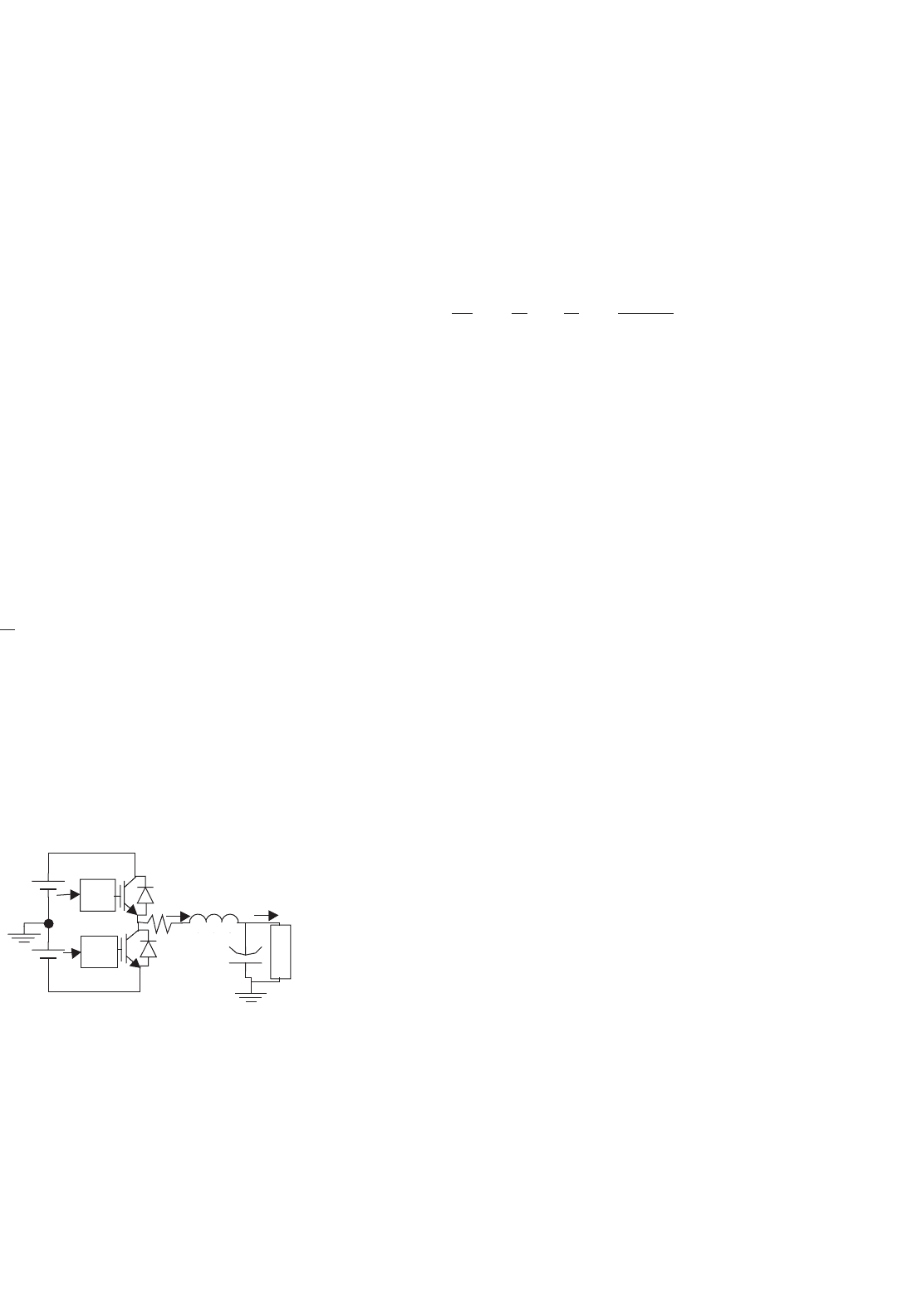
962 J. F. Silva and S. F. Pinto
to reach the sliding mode of operation with step
disturbances.
The block diagram (Fig. 34.26a) of the implemented
control law Eq. (34.102) (with C
o
k
1
/k
2
= 4) and switch-
ing law (34.103) (with ε = 0.3) does not included the
time derivative of the reference (dv
o
r
/dt) since, in a
dc/dc converter its value is considered zero. The con-
troller hardware (or software), derived using just the
sliding-mode approach, operates only in a closed-loop.
The resulting performance (Fig. 34.26b) is much bet-
ter than that obtained with the PID notch filter (compare
to Example 34.4, Fig. 34.9b), with a higher response
speed and robustness against power-supply variations.
E
XAMPLE 34.11 Sliding mode control of the single-
phase half-bridge converter
Consider the half-bridge four quadrant converter of
Fig. 34.27 with the output filter and the inductive load
(V
DCmax
= 300 V; V
DCmin
= 230 V; R
i
= 0.1 ;
L
o
= 4 mH; C
o
= 470 µF; inductive load with nominal
values R
o
= 7 , L
o
= 1 mH).
Assuming that power switches, output filter capacitor,
and power supply are all ideal, and a generic load with
allowed slow variations, the switched state-space model
of the converter, with state variables v
o
and i
L
,is
d
dt
v
o
i
L
=
01/C
o
−1/L
o
−R
i
/L
o
v
o
i
L
+
−1/C
o
0
01/L
o
i
o
δ(t)V
DC
(34.105)
where i
o
is the generic load current and v
PWM
=
δ(t)V
DC
is the extended PWM output voltage (δ(t) =
+1 when one of the upper main semiconductors of
Fig. 34.27 is conducting and δ(t) =−1 when one of
the lower semiconductors is on).
d
− V
PWM
i
L
+
V
DC
−
S
2
R
i
L
o
+
v
o
−
C
o
+
V
DC
−
L
o
a
i
o
Driver
S
1
Driver
+
FIGURE 34.27 Half-bridge power inverter with insulated gate bipolar
transistors, output filter, and load.
34.3.5.1 Output Current Control (Current-mode
Control)
To perform as a v
i
L
voltage controlled i
L
current source (or
sink) with transconductance g
m
(g
m
= i
L
/v
i
L
), this converter
must supply a current i
L
to the output inductor, obeying
i
L
= g
m
v
i
L
. Using a bounded v
i
L
voltage to provide output
short-circuit protection, the reference current for a sliding-
mode controller must be i
L
r
= g
m
v
i
L
. Therefore, the controlled
output is the i
L
current and the controllability canonical model
(34.106) is obtained from the second equation of (34.105),
since the dynamics of this subsystem, being governed by
δ(t)V
DC
, is already in the controllability canonical form for
this chosen output.
di
L
dt
=−
R
i
L
o
i
L
−
1
L
o
v
o
+
δ(t)V
DC
L
o
(34.106)
A suitable sliding surface (34.107) is obtained from
Eq. (34.91), making e
i
L
= i
L
r
−i
L
.
S(e
i
L
, t) = k
p
e
i
L
= k
p
(i
L
r
−i
L
) = k
p
(g
m
v
i
L
−i
L
) = 0
(34.107)
The switching law Eq. (34.108) can be devised calculat-
ing the time derivative of Eq. (34.107)
˙
S(e
i
L
, t), and applying
Eq. (34.92). If S(e
i
L
, t) > 0, then di
L
/dt > 0 must hold to
obtain
˙
S(e
i
L
, t) < 0, implying δ(t) = 1.
δ(t) =
1 for S(e
i
L
, t) > +e
−1 for S(e
i
L
, t) < −e
(34.108)
The k
p
value and the allowed the ripple ε define the
instantaneous value of the variable switching frequency. The
sliding-mode controller is represented in Fig. 34.28a. Step
response (Fig. 34.29a) shows the variable-frequency operation,
a very short rise time (limited only by the available power
supply) and confirms the expected robustness against supply
variations.
For systems where fixed-frequency operation is needed, a
triangular wave, with frequency (10 kHz) slightly greater than
the maximum variable frequency, can be added (Fig. 34.28b)
to the sliding-mode controller, as explained in Section 34.3.3.
Performances (Fig. 34.29b) are comparable to those of
the variable-frequency sliding-mode controller (Fig. 34.29a).
Fig. 34.29b shows the constant switching frequency, but also a
steady-state error dependent on the operating point.
To eliminate this error, a new sliding surface Eq. (34.109),
based on Eq. (34.99), should be used. The constants k
p
and k
0
can be calculated, as discussed in Example 34.10.
S(e
i
L
, t) = k
0
e
i
L
dt +k
p
e
i
L
= 0 (34.109)
The new constant-frequency sliding-mode current con-
troller (Fig. 34.30a), with added antiwindup techniques
(Example 34.6), since a saturation (errMax) is needed to keep
the frequency constant, now presents no steady-state error
(Fig. 34.30b). Performances are comparable to those of the
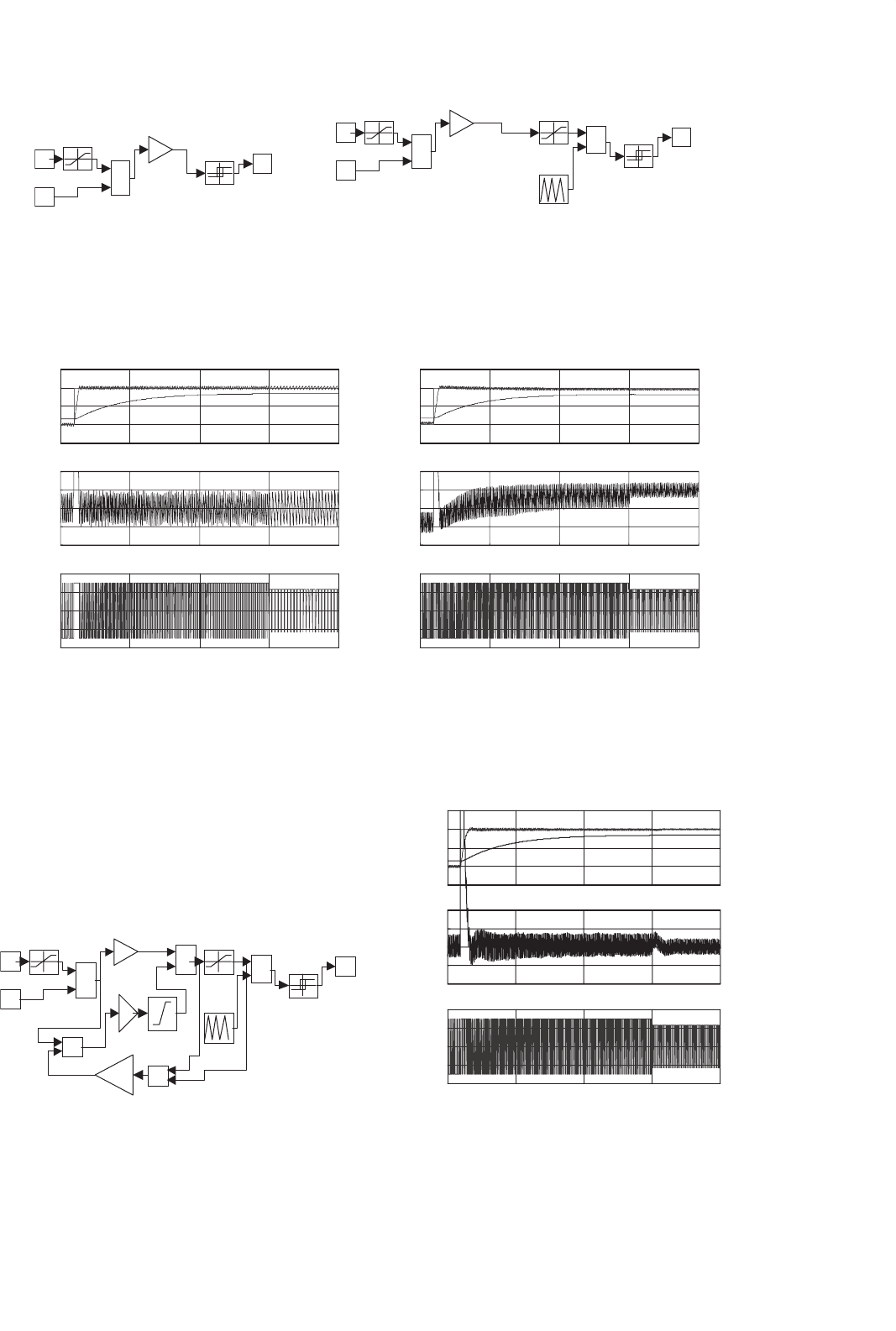
34 Control Methods for Switching Power Converters 963
error
Comparator = 0.02
2
iL
1
iLr
+
−
eiL
iLMax
1
kp
1
delta
Switching
law epsilon= 2
2
iL
1
iLr
+
−
eiL
iLMax
1
kp
1
delta
+
−
Sum1
errMax
PWM
triangle
(a) (b)
+
−
+
−
FIGURE 34.28 (a) Implementation of short-circuit-proof sliding-mode current controller (variable frequency) and (b) implementation of fixed
frequency, short-circuit-proof sliding-mode current controller using a triangular waveform.
–40
–20
0
20
40
Variable switching frequency
1->iLr2->iL [A], 3->vo/10 [V]
t [s]
t [s]
t [s]
1
2
3
–40
–20
0
20
40
10*eiL [A]
–400
–200
0
200
400
Vpwm [V]
–40
–20
0
20
40
Constant switching frequency
1->iLr2->iL [A], 3->vo/10 [V]
1
2
3
0 0.005 0.01 0.015 0.02
–40
–20
0
20
40
10*eiL [A]
0 0.005 0.01 0.015 0.02
–400
–200
0
200
400
Vpwm [V]
t [s]
t [s]
(a) (b)
0 0.005 0.01 0.015 0.02
t [s]
0 0.005 0.01 0.015 0.02
0 0.005 0.01 0.015 0.02
0 0.005 0.01 0.015 0.02
FIGURE 34.29 Performance of the transconductance amplifier; response to a i
Lr
step from −20 to 20 A at t = 0.001 s and to a V
DC
step from 300
to 230 V at t = 0.015 s: (a) variable-frequency sliding-mode controller and (b) fixed-frequency sliding-mide controller.
2
i
L
1
i
L
r
+
−
+
−
−
−
−
e
iL
iLMax
1
k
p
1
delta
error
Comparator = 0.02
Sum1
+
+
PI
1/s
Limited
Integrator
+
Sum2
300
kw
+
Sum4
-K
k
0
PWM
triangle
errMax
0 0.005 0.01 0.015 0.02
–40
–20
0
20
40
1->iLr2->iL [A], 3->vo/10 [V]
t [s]
1
2
3
0 0.005 0.01 0.015 0.02
–40
–20
0
20
40
10*eiL [A]
t [s]
0 0.005 0.01 0.015 0.02
–400
–200
0
200
400
Vpwm [V]
t [s]
(a) (b)
+
FIGURE 34.30 (a) Block diagram of the average current-mode controller (sliding mode) and (b) performance of the fixed-frequency sliding-mode
controller with removed steady-state error: response to a i
L
r
step from −20 to 20 A at t = 0.001 s and to a V
DC
step from 300 to 230 V at t = 0.015 s.

964 J. F. Silva and S. F. Pinto
variable-frequency controller, and no robustness loss is visi-
ble. The applied sliding-mode approach led to the derivation
of the known average current-mode controller.
34.3.5.2 Output Voltage Control
To obtain a power operational amplifier suitable for building
uninterruptible power supplies, power filters, power gyrators,
inductance simulators, or power factor active compensators,
v
o
must be the controlled converter output. Therefore, using
the input–output linearization technique, it is seen that the
first time derivative of the output (dv
o
/dt) = (i
L
−i
o
)/C
o
= θ,
does not explicitly contain the control input δ(t)V
DC
. Then,
the second derivative must be calculated. Taking into account
Eq. (34.105), as θ = (i
L
−i
o
)/C
o
, Eq. (34.110) is derived.
d
2
v
o
dt
2
=
d
dt
θ =
d
dt
i
L
−i
o
C
o
=−
R
i
L
o
θ −
1
L
o
C
o
v
o
−
R
i
L
o
C
o
i
o
−
1
C
o
di
o
dt
+
1
L
o
C
o
δ(t)V
DC
(34.110)
This expression shows that the second derivative of the
output depends on the control input δ(t)V
DC
. No further
time derivative is needed, and the state-space equations of the
equivalent circuit, written in the phase canonical form, are
d
dt
v
o
θ
=
θ
−
R
i
L
o
θ −
1
L
o
C
o
v
o
−
R
i
L
o
C
o
i
o
−
1
C
o
di
o
dt
+
1
L
o
C
o
δ(t)V
DC
(34.111)
According to Eqs. (34.91), (34.111), and (34.105), consid-
ering that e
v
o
is the feedback error e
v
o
= v
o
r
− v
o
, a sliding
surface S(e
v
o
, t), can be chosen:
S(e
v
o
,t)=k
1
e
v
o
+k
2
de
v
o
dt
=e
v
o
+
k
2
k
1
de
v
o
dt
=e
v
o
+β
de
v
o
dt
=
C
o
β
(v
o
r
−v
o
)+C
o
dv
o
r
dt
+i
o
−i
L
=0
(34.112)
where β is the time constant of the desired first-order response
of output voltage (β T > 0), as the strong relative degree
[14] of this system is 2, and the sliding-mode operation reduces
by one, the order of this system (the strong relative degree
represents the number of times the output variable must be
time differentiated until a control input explicitly appears).
Calculating
˙
S(e
v
o
, t), the control strategy (switching law)
Eq. (34.113) can be devised since, if S(e
v
o
, t) > 0, then di
L
/dt
must be positive to obtain
˙
S(e
i
L
, t) < 0, implying δ(t ) = 1.
Otherwise, δ(t) =−1.
δ(t) =
1 for S(e
v
o
, t) > 0(v
PWM
=+V
DC
)
−1 for S(e
v
o
, t) < 0(v
PWM
=−V
DC
)
(34.113)
In the ideal sliding-mode dynamics, the filter input voltage
v
PWM
switches between V
DC
and −V
DC
with the infinite fre-
quency. This switching generates the equivalent control voltage
V
eq
that must satisfy the sliding manifold invariance con-
ditions, S(e
v
o
, t) = 0 and
˙
S(e
v
o
, t) = 0. Therefore, from
˙
S(e
v
o
, t) = 0, using Eqs. (34.112) and (34.105), (or from
Eq. (34.110)), V
eq
is
V
eq
= L
o
C
o
d
2
v
o
r
dt
2
+
1
β
dv
o
r
dt
+
v
o
L
o
C
o
+
(βR
i
−L
o
)i
L
βL
o
C
o
i
o
βC
o
+
1
C
o
di
o
dt
(34.114)
This equation shows that only smooth input v
o
r
sig-
nals (“smooth” functions) can be accurately reproduced at
the inverter output, as it contains derivatives of the v
o
r
signal.
This fact is a consequence of the stored electromagnetic
energy. The existence of the sliding-mode operation implies
the following necessary and sufficient condition:
−V
DC
< V
eq
< V
DC
(34.115)
Equation (34.115) enables the determination of the mini-
mum input voltage V
DC
needed to enforce the sliding-mode
operation. Nevertheless, even in the case of |V
eq
| > |V
DC
|,
the system experiences only a saturation transient and even-
tually reaches the region of sliding-mode operation, except if,
in the steady state, operating point and disturbances enforce
|V
eq
| > |V
DC
|.
In the ideal sliding mode, at infinite switching frequency,
state trajectories are directed toward the sliding surface and
move exactly along the discontinuity surface. Practical switch-
ing converters cannot switch at infinite frequency, so a typical
implementation of Eq. (34.112) (Fig. 34.31a) with neglected
˙v
o
r
features a comparator with hysteresis 2ε, switching occur-
ring at |S(e
v
o
, t)| >εwith frequency depending on the slopes
of i
L
. This hysteresis causes phase-plane trajectory oscillations
of width 2ε around the discontinuity surface S(e
v
o
, t) = 0, but
the V
eq
voltage is still correctly generated, since the resulting
duty cycle is a continuous variable (except for error limitations
in the hardware or software, which can be corrected using the
approach pointed out by Eq. (34.98)).
The design of the compensator and the modulator is inte-
grated with the same theoretical approach, since the signal
S(e
v
o
, t) applied to a comparator generates the pulses for the
power semiconductors drives. If the short-circuit-proof oper-
ation is built into the power semiconductor drives, there is the
possibility to measure only the capacitor current (i
L
−i
o
).
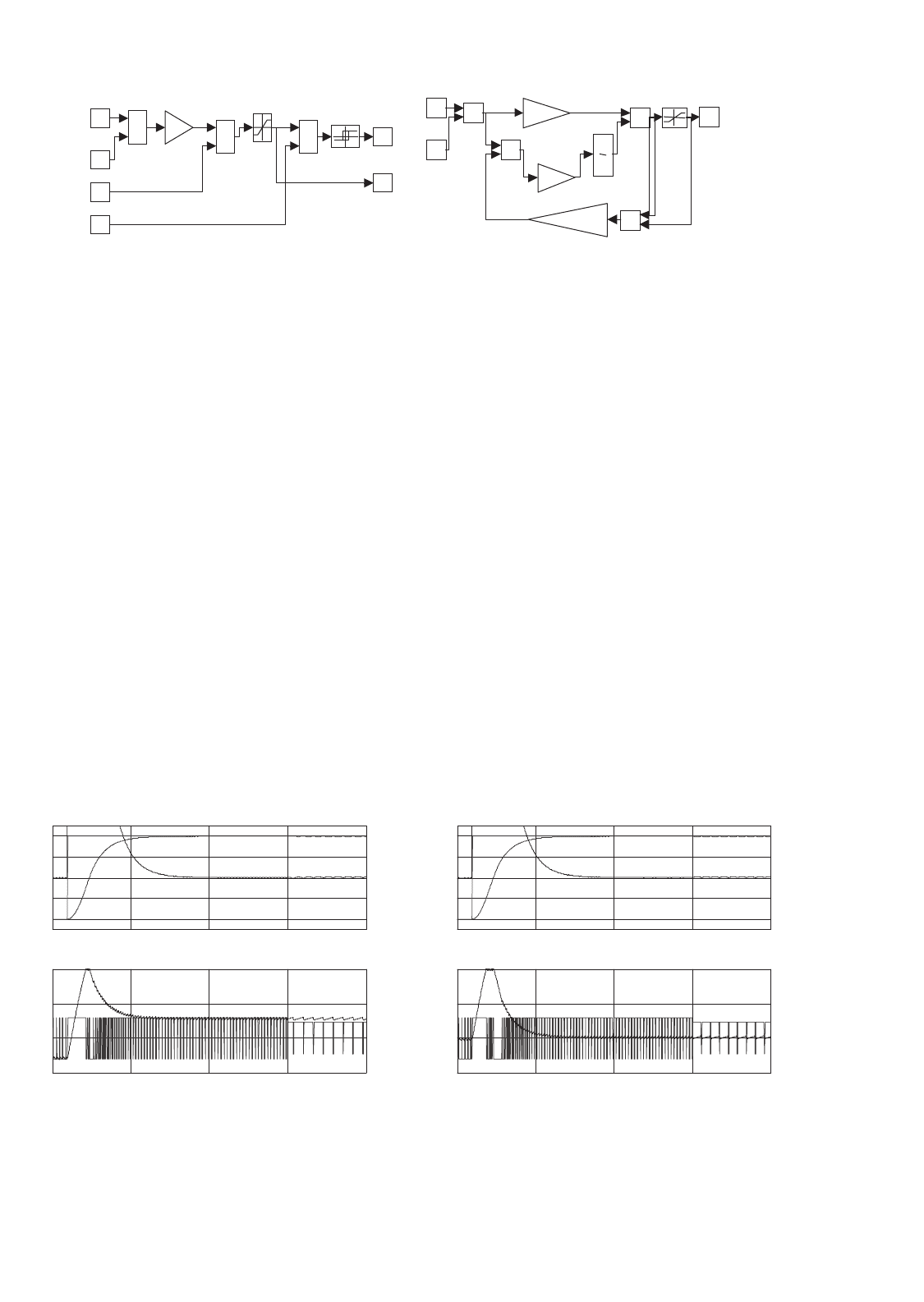
34 Control Methods for Switching Power Converters 965
2
vo
1
vor
3
io
4
iL
+
−
evo
1
delta
Switching
law
+
−
Sum1
0.5
Co*k1/k2
2
iLr
+
+
Sum2
iLrMax
1
vor
2
vo
0.392
Kp=Co/2Td
+
−
evo
+
−
Sum2
s
1
Integral error
1
iLriLrMax
+
+
Sum
+
−
Sum1
119
Ki=1/2RoTd
304
kw=ki/kp
(a) (b)
FIGURE 34.31 (a) Implementation of short-circuit-proof, sliding-mode output voltage controller (variable frequency) and (b) implementation of
antiwindup PI current-mode (fixed frequency) controller.
34.3.5.3 Short-circuit Protection and Fixed-frequency
Operation of the Power Operational
Amplifier
If we note that all the terms to the left of i
L
in Eq. (34.112)
represent the value of i
L
r
, a simple way to provide short-circuit
protection is to bound the sum of all these terms (Fig. 34.31a
with i
L
rmax
= 100 A). Alternatively, the output current con-
trollers of Fig. 34.28 can be used, comparing Eq. (34.107)
to Eq. (34.112), to obtain i
L
r
= S(e
v
o
, t)/k
p
+ i
L
. Therefore,
the block diagram of Fig. 34.31a provides the i
L
r
output (for
k
p
= 1) to be the input of the current controllers (Fig. 34.28
and Fig. 34.31a). As seen, the controllers of Fig. 34.28b and
Fig. 34.30a also ensure fixed-frequency operation.
For comparison purposes a proportional–integral (PI) con-
troller, with antiwindup (Fig. 34.31b) for output voltage
control, was designed, supposing the current-mode control
of the half bridge (i
L
r
= g
m
v
i
L
/(1 + sT
d
) considering a small
delay T
d
), a pure resistive load R
o
, and using the approach
outlined in Examples 34.6 and 34.8 (k
v
= 1, g
m
= 1, ζ
2
= 0.5,
0 0.005 0.01 0.015 0.02
–200
–100
0
100
200
Sliding mode
1->vor, 2->vo,3->evo [V]
t [s]
1
2
3
0 0.005 0.01 0.015 0.02
–50
0
50
100
1->iL[A], 2->Vpwm/10 [V]
t [s]
1
2
0 0.005 0.01 0.015 0.02
–200
–100
0
100
200
Sliding mode (Ro*20)
1->vor, 2->vo,3->evo [V]
t [s]
1
2
3
0 0.005 0.01 0.015 0.02
–50
0
50
100
1->iL[A], 2->Vpwm/10 [V]
t [s]
1
2
FIGURE 34.32 Performance of the power operational amplifier; response to a v
o
r
step from −200 to 200 V at t = 0.001 s and to a V
DC
step from
300 to 230 V at t = 0.015 s: (a) variable-frequency sliding mode (nominal load) and (b) variable-frequency sliding mode (R
o
×20).
T
d
= 600 µs). The obtained PI (34.50) parameters are
T
z
= R
o
C
o
T
p
= 4ζ
2
g
m
k
v
R
o
T
d
(34.116)
Both variable frequency (Fig. 34.32) and constant frequency
(Fig. 34.33) sliding-mode output voltage controllers present
excellent performance and robustness with nominal loads.
With loads much higher than the nominal value (Fig. 34.32b
and Fig. 34.33b), the performance and robustness are also
excellent. The sliding-mode constant-frequency PWM con-
troller presents the additional advantage of injecting lower
ripple in the load.
As expected, the PI regulator presents lower performance
(Fig. 34.34). The response speed is lower and the insensitivity
to power supply and load variations (Fig. 34.34b) is not as high
as with the sliding mode. Nevertheless, the PI performances
are acceptable, since its design was carried considering a slow
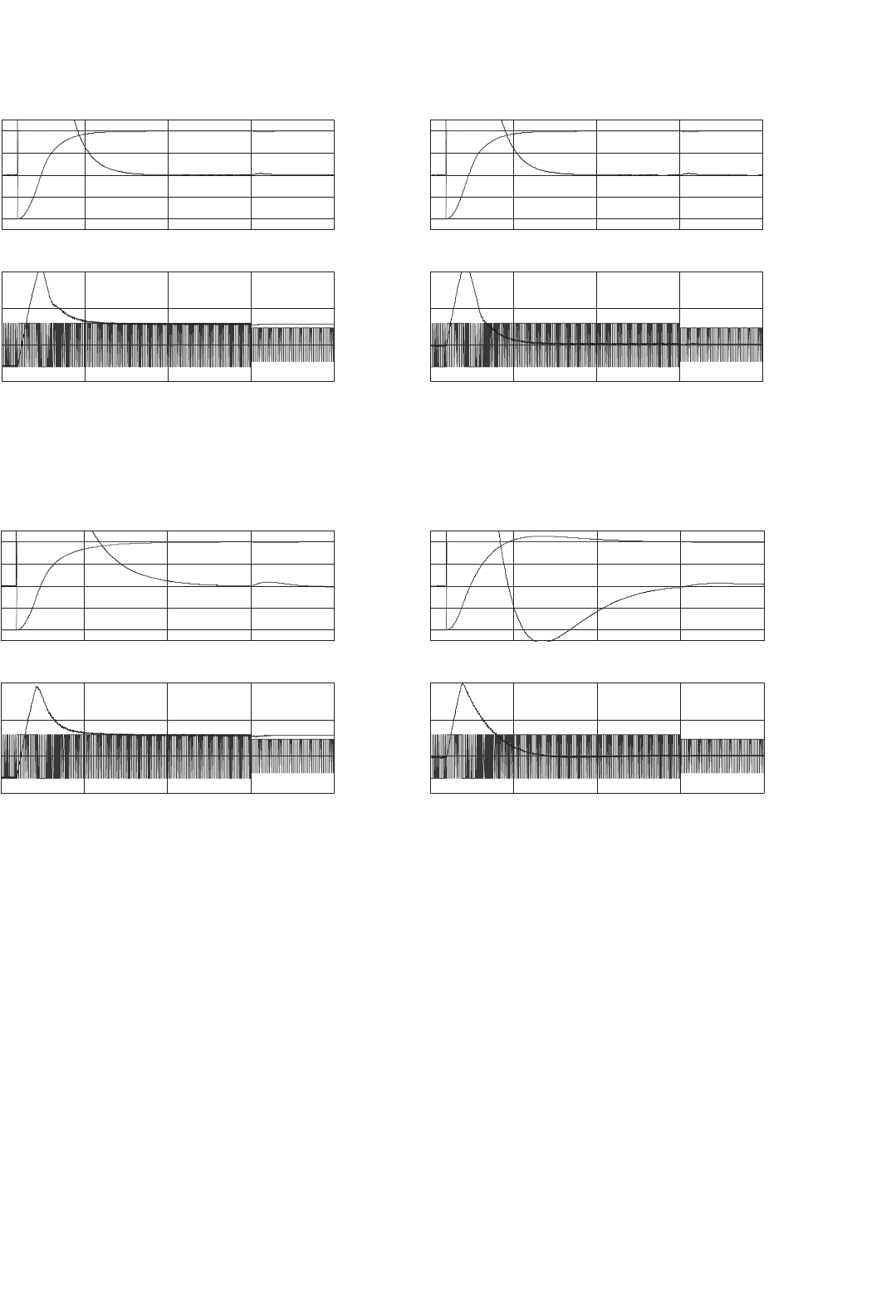
966 J. F. Silva and S. F. Pinto
000.005 0.01 0.015 0.02
−200
−100
0
100
200
Fixed frequency sliding mode
1->vor, 2->vo,3->evo [V]
t [s]
1
2
3
0 0.005 0.01 0.015 0.02
−50
0
50
100
1->iL[A], 2->Vpwm/10 [V]
t [s]
1
2
0.005 0.01 0.015 0.02
Fixed frequency sliding mode (Ro*20)
1->vor, 2->vo,3->evo [V]
t [s]
1
2
3
0 0.005 0.01 0.015 0.02
1->iL[A], 2->Vpwm/10 [V]
t [s]
1
2
−200
−100
0
100
200
−50
0
50
100
FIGURE 34.33 Performance of the power operational amplifier; response to a v
o
r
step from −200 to 200 V at t = 0.001 s and to a V
DC
step from
300 to 230 V at t = 0.015 s: (a) fixed-frequency sliding mode (nominal load) and (b) fixed-frequency sliding mode (R
o
×20).
0 0.005 0.01 0.015 0.02
−200
−100
0
100
200
PI & current mode
1->vor, 2->vo, 3->evo [V]
t [s]
1
2
3
0 0.005 0.01 0.015 0.02
−50
0
50
100
1->iL[A], 2->Vpwm/10 [V]
t [s]
1
2
0 0.005 0.01 0.015 0.02
−200
−100
0
100
200
PI & current mode (Ro*20)
1->vor, 2->vo, 3->evo [V]
t [s]
1
2
3
0 0.005 0.01 0.015 0.02
−50
0
50
100
1->iL[A], 2->Vpwm/10 [V]
t [s]
1
2
FIGURE 34.34 Performance of the PI controlled power operational amplifier; response to a v
o
r
step from −200 to 200 V at t = 0.001 s and to a V
DC
step from 300 to 230 V at t = 0.015 s: (a) PI current-mode controller (nominal load) and (b) PI current-mode controller (R
o
×20).
and fast manifold sliding-mode approach: the fixed-frequency
sliding-mode current controller (34.109) for the fast manifold
(the i
L
current dynamics) and the antiwindup PI for the slow
manifold (the v
o
voltage dynamics, usually much slower than
the current dynamics).
E
XAMPLE 34.12 Constant-frequency sliding-mode con-
trol of p pulse parallel rectifiers
This example presents a new paradigm to the control of
thyristor rectifiers. Since p pulse rectifiers are variable-
structure systems, sliding-mode control is applied here
to 12-pulse rectifiers, still useful for very high-power
applications [3]. The design determines the variables to
be measured and the controlled rectifier presents robust-
ness, and much shorter response times, even with the
parameter uncertainty, perturbations, noise, and non-
modeled dynamics. These performances are not feasible
using linear controllers, obtained here for comparison
purposes.
34.3.5.4 Modeling the 12-pulse Parallel Rectifier
The 12-pulse rectifier (Fig. 34.35a) is built with four three-
phase half-wave rectifiers, connected in parallel with current-
sharing inductances l and l
merged with capacitors C
, C
2
,to
